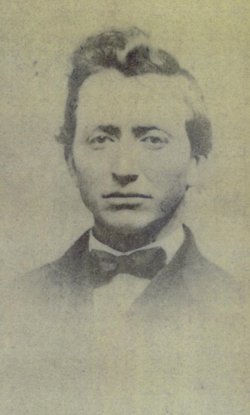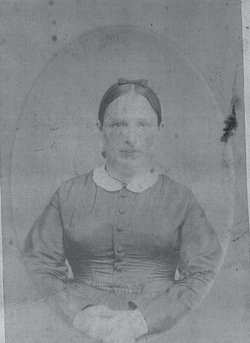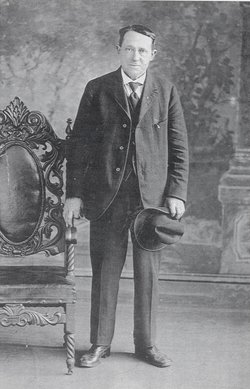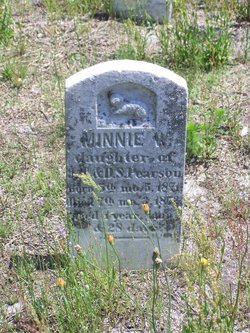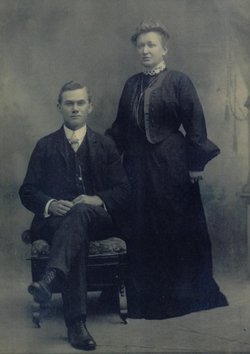| Description |
: |
The following information regarding John Newlin Pearson and Sarah Massey Pearson is quoted directly from "History of the Pearson Family of Wayne County, North Carolina 1700-1981," compiled in 1982 by their daughter, Ruth Pearson Harper (1901-1985) of Roanoke, Alabama, pages 78-83:
The untimely death of John Thomas Pearson in 1877 made it necessary for the two older sons, Joe and John, to assume the responsibilities of grown men at the ages of 18 and 16; they plowed, harvested grain, operated the cotton gin, and did anything else necessary. Their education was cut short. Even though schools ran only three months, John...
Read More
|
The following information regarding John Newlin Pearson and Sarah Massey Pearson is quoted directly from "History of the Pearson Family of Wayne County, North Carolina 1700-1981," compiled in 1982 by their daughter, Ruth Pearson Harper (1901-1985) of Roanoke, Alabama, pages 78-83:
The untimely death of John Thomas Pearson in 1877 made it necessary for the two older sons, Joe and John, to assume the responsibilities of grown men at the ages of 18 and 16; they plowed, harvested grain, operated the cotton gin, and did anything else necessary. Their education was cut short. Even though schools ran only three months, John was out until he was 21. Then he attended Woodland Academy for two years, boarding with the Jesse Hollowell family whose property adjoined the school and church.
Here is an appropriate place to tell about Woodland Meeting and Academy. Quaker families--Moores, Hollowells, and others--began holding Bible school and meetings for worship in the Mineral Springs School House located at Everettsville. Everettsville was the home of planters who owned bottom land along Neuse River; after the war these families moved to Goldsboro. It was about two miles north of Dudley along the Atlantic Coast Line Railroad. The school was named for a large mineral spring close by. An indulged meeting status was granted to Mineral Springs in June 1873. ("Indulged" was the term for a new meeting that might not survive.) In 1874 Jesse Hollowell gave land for a meeting house and academy and also a cemetery near his home. At the cost of $600.00 a one-room meeting house was erected. It is said that the word "Woodland" on the side of the wood stove inspired the members to name the meeting Woodland.
The first monthly meeting was organized in August 1883; now it had equal rank with Neuse and Nahunta. The one hundred first anniversary was celebrated in 1974. Ministers of the congregation who served without salary were Lancaster John Moore, grandfather of Lyman Moore; John Sanders Moore, father of Rev. Hugh W. Moore; and Micajah T. Cox, father of Eugene Cox.
The school house at Everettsville, a two story structure with one large and one small room and an entrance hall on each floor, was moved to one part of the land donated by Jesse Hollowell. A small road separated church and school. In the early 1880's Professor Cyrus Frazier of Guilford County was the principal; he had a lady assistant. One of these was Miss Julia Mendenhall, daughter of Nereus Mendenhall, superintendent of New Garden Boarding School; she married George C. Moore, son of L.J. Moore and father of Lyman Moore.
The academy became a public school in the early 1900's with two teachers. The building was used until about 1922 when Wayne County built a new Woodland High School on the adjacent lot bought from John N. Pearson in 1916. Then the old building was used for a teacherage and later for apartments. Now it has been pushed back into a wooded area and is owned by a family.
When Woodland was consolidated into Brogden Township High School built at old Everettsville about 1930, Woodland Meeting bought the building and used it for a meeting house until the 1950's. About 1940 the old meeting house was sold and a brick parsonage built on the site. The new brick meeting house was built on the site of the old school house and the lumber of the second school-church was used for the framework of the handsome brick meeting house. A fellowship hall was added later at the back.
John Pearson remembered vividly some incidents in the school room of Prof. Frazier and loved to reminisce at the supper table. Among the students were the daughters of Levi Massey who rode four miles through the sand, so that the trip took an hour.
Sarah Smiley Massey was born soon after the end of the Civil War. Her parents named her for Sarah Smiley, a Quaker preacher from Baltimore who came down at that time to visit Quaker families and to distribute her store of medicines, food, and clothing. She was a very shy girl. John and Sarah married when she was 19 and he was 23 at the Massey home on Dec. 23, 1884. He did not wish to be married in meeting--that would be too public--so they were married by a justice of the peace.
John and Sarah rode the 14 miles to the Pearson settlement and began work next morning. He had inherited 32.5 acres and later he bought 50 mor
Because Lucy died of malaria in 1900, he sold this fertile black land and moved to a sandy place five miles south of Goldsboro in Brogden Township. The location was much more healthful. In those days very few houses were screened. When Ruth was in grammar school, John and Sarah learned from her book on sanitation that malaria was carried by mosquitoes and not due to breathing "bad air" along the river. At Woodland it was not necessary to take quinine to prevent chills and fever.
This farm of 312 acres had a good deal of forest with many original long leaf pines. John sold 73 acres to his brother, James R. Pearson. The original house of five rooms and a front porch was built about 1875 in a grove of oaks by an Edgerton, John Henry, I think. The next owner, William H. Overman, added a second story, double front porches, and a dining room; it is uncertain which owner put the breezeway between the main part and the ell. So it became a ten room house with nine fireplaces, two halls, two front porches, and a breezeway, but there was no way to heat the dining room. The breezeway was a very pleasant place to sit; John added doors on the north side. About 1926 he added a spacious porch on the south side of the kitchen, dining room, and breezeway; the well was now on the porch. That year Earl painted the house again after the lapse of at least 25 years.
This house and farm were just across the road from Woodland MH and Woodland School. It was only a minute's dash to school and the children ate dinner at home. A private road led to the Woodland Cemetery and up a slight hill to the home of Elijah and Melvina Edwards who now owned the Jesse Hollowell home and farm. Their ten children's ages corresponded somewhat with ours. By his first marriage he had six children--all married by the early 1900's. What a family it was in those days of large families!
The early 1900's were full of tragedy. The summer before Lucy died, Leslie was kicked in the head by a mule, was operated on at home, and survived. Sarah had a long illness when Sallie was born. Her sisters, Rachel and Alice Massey, nursed her and cooked for the family. Harold died of stomach cancer three or four months after measles. Of the other five children, Mary and Leslie both died of cancer. Earl died suddenly at the age of 79.
John and Sarah worked very hard to achieve their ambition to give each child a college education, something very few farmers were able to do in those days. All five graduated from Guilford with good academic records.
Both were loyal and active members of Woodland Meeting. Although they did not attend the Wednesday morning meeting, Sarah was always present at monthly meeting on Saturday morning, and they seldom missed quarterly meeting. John was made an elder in 1909. The children attended all the activities of the church and community. The Christian Endeavor Society met on Sunday night but there was no preaching at night. There were revival meetings of the quiet kind. The church had a reed organ as far back as I remember and later a piano. We sang heartily from "Gospel Hymns: Nos. 1-6," a big collection of the best from the era of Fanny J. Crosby and Ira D. Sankey. Other books came later, and eventually "The Cokesbury Hymnal," a Methodist song book.
In the Woodland neighborhood the standards of conduct were strict among Friends, Methodists, and Baptists: dancing, drinking, gambling, and card games were not tolerated. However, a few young men dared smoke cigarettes; strangely enough, some chewed tobacco or dipped snuff but disapproved of cigarettes, popularly called "coffin nails." Country baseball, ice cream parties, box suppers, picnics at Myrtle Springs, the property of John S. Moore, and Fourth of July trips to Seven Springs, 17 miles away on the eastern side of the county, were some of the favorite events. Hunting arbutus flowers in the sandhills, gathering heart leaves and chinquapins were for those who had to walk. Eventually basketball became a school sport; all games were played outdoors; no matter how cold the weather, we all went.
The family especially enjoyed the company of visiting ministers. The fourth weekend in July Contentnea Quarterly Meeting was held at Woodland for three days; it was one of the events of the year before the automobile changed everything. On Friday came one session, the Meeting on Ministry and Oversight; on Saturday general business and preaching with picnic dinner at noon; and on Sunday preaching with lots of company from the area. We always expected to have overnight guests, especially relatives. Nowadays quarterly meeting can be disposed of in one night session. Conversation was important, and we would sit at the dinner or supper table just talking over old times, baseball scores from the paper that came by mail, family events of the past, or what had happened at Guilford College. In this way our parents told us the history of their families as well as who was who among the Quakers.
John and Sarah had very little leisure time. John went to Yearly Meeting at Guilford College a few times. Sarah attended the graduations of Ruth and Sallie. Sometimes some of the family would go to Wilmington on the Sunday excursion of the Atlantic Coast Line and then down to Wrightsville Beach for the day. Once John visited his brother Joseph at Keysville, Va.; he brought home the seed of a chestnut oak which made a fine tree in the front yard. On Saturday afternoons he delivered butter and eggs to customers in Goldsboro, and there he met his brothers. Sarah seldom got to town, but she never failed to read the newspapers, magazines, and books available to the family. For about 40 years she subscribed to "The Christian Herald"; she really loved the sermons, the articles by Margaret E. Sangster, and the continued novels. We first read about Pollyanna in this excellent weekly. The book was always held in high regard in the home, and it was no trouble to keep the children interested in lessons.
In 1905 rural free delivery of mail was begun; before that the boys went to Genoa to get the mail. In 1911 a telephone line was built with 11 subscribers, but service was often very poor if we wanted to talk to a person on another rural line. John was treasurer for the line. Back then nobody made a long distance call unless there was serious illness, death, or a very important matter of business. There was nothing casual about it. Telegrams were relayed by telephone. That scared us too.
John stressed the need to make the farm supply the basics and not to rely on cash crops, cotton and tobacco. Cotton was work enough but tobacco he considered a slave crop. He never had to buy corn, fodder, or hay. He raised soybeans, velvet beans, field peas, watermelons, sweet potatoes, Irish potatoes, to sell or to fatten the hogs or cows. Then there were pork products or cows for sale in winter. By living at home, he always had something to sell for cash, and there was then a good local market in Goldsboro; but good roads made the day for the big trucks full of produce about 1930 and thereafter.
Once an article in the Goldsboro newspaper commented on the fact that John N. Pearson had brought a wagonload of hay to town to sell; it was baled too. Many farmers bought western hay and hauled it to their farms, depending on cotton and tobacco for cash and neglecting to produce the necessary feed while they were busy curing the tobacco crop. John did raise cotton and we helped pick it, but Negroes picked most of it.
John always had some money, and he never gave a mortgage on his property, as so many farmers did, to get the year's supply of fertilizer and seed. Saving various kinds of seed was a family habit. Though the farm was not large--two or three tenants after the boys were no longer there--he was successful. As new practices were introduced and explained in the farm papers, he adapted them to the situation. Various small houses in the yard were removed. A new well was dug near the barn and another close to the kitchen door. In the early years a new barn, stables, and shelters for tools and vehicles were built as needed. To clear a pasture of bushes, he bought some goats which were always fascinating animals--cows, horses, and mules, and pigs of different sizes couldn't equal the antics of those billy goats and the tiny kids.
Since the trees in the front yard were never very good, John soon planted water oaks and the one chestnut oak. When he arrived there were more than 20 scuppernong and James (muscadine) grape vines on the south side of the house; after these were trellised, they yielded many grapes to eat and to sell. How delicious they were in a shaded place in the early morning. He set out various fruit trees; much later Earl set out figs.
Shrubbery as we know it was not found in any front yard in the neighborhood. Yards were swept clean with brush brooms, and grass was considered an enemy. We did have several cape jessamines (gardenias) which fluorished in the sandy acid soil. There were red rambler roses and blue iris, but the prettiest bush was the Japanese quince that put forth its red blossoms in early spring. Later Earl gathered native shrubs from the woods.
For home entertainment we had first a roller organ; all the rollers were favorite hymns. Then Earl bought a parlor organ--walnut with a fancy top--and some simple pieces of sheet music like "Silver Threads Among the Gold," and "When You and I Were Young, Maggie." He also got the songs of Carrie Jacobs Bond--"I Love You Truly" and "A Perfect Day," and along the way we played and sang from the hymnal. When we were a little older, we got a piano and played more difficult pieces, but nobody was an accomplished musician.
Earl bought a Victrola (phonograph) and we all enjoyed the records. John especially enjoyed the comic record, "The Preacher and the Bear." He never owned a radio, for it was a rather new thing when he died. John never owned a car or learned to drive one. Sarah never had the modern conveniences because electricity was not available on the farm, although the main line of Carolina Power and Light was built right through the woods in 1926. Uncle Jimmy often asked why we didn't get a kerosene stove to cook on so the kitchen would be cooler. There was still plenty of wood and a saw to cut it. We did have an iceless refrigerator once to keep the milk cooler. For a number of years we girls belonged to the 4-H canning club; we had our patches of tomatoes and stringless beans and a canner to cook the cans after we had filled them at a table in the shade. John sold the canned vegetables to customers in Goldsboro. We were kept very busy every day working at something; after the fruit and vegetables were getting scarce, we began to sew for the next school year.
The movie made its impact upon our lives and changed our concept of the world beyond Goldsboro and what we read in the daily paper. Earl never bought a television set; the radio and the daily paper satisfied him.
Our friends and relatives came more often in the fall, for they loved to stand under the vines and eat to their heart's (or stomach's) content. Country people, who didn't have cold Coca-cola on hand, took their guests out to the peach trees, the fig bushes, or the grapevines, and then they had some cool water just pumped or drawn from the well.
John once said that he didn't want to have any business he couldn't discuss with his family, a most admirable attitude, in my opinion. However, in their time most parents were very reticent about many matters which are discussed quite openly today. Victorian manners demanded that children not know some facts of life at an early age. In conversation they yielded the floor to adults. Parents adored their children, but the children knew who was the head of the family. A switching or spanking was administered appropriately. The children of our family sat still in church without much prodding. Love, obedience, sincerity, reliability, independence, and honesty in all matters were the highest virtues with them.
John died on 12-18-1928 after a week of pneumonia resulting from a trip to the woods for pinestraw on a blustery morning. He became delirious during the weekend and died on Tuesday. Sarah went to bed the day after the funeral and died of double pneumonia and heart trouble exactly four weeks after John on 1-15-1929. Their funerals were conducted by the Rev. Ben Millikan. He spoke especially of John's zeal for education; he had stated quite recently that the youngest child was in her senior year at Guilford. Sarah shared the same enthusiasm for education.
This is a brief account of how it was down on the farm in the first third of the 20th century. The house now belongs to strangers. There is hardly a name on the church roll from the original families of Moores, Pearsons, Hollowells, Coxes, Davises, Masseys, and a few others. As the French say, "The only constant thing is change."
This ends the quoted information from Ruth Pearson Harper. John and Sarah were related several ways. They were double cousins through the Cox family, as John was descended from Thomas Cox, Sr. and Sarah Busby Cox through their son Thomas and Sarah's mother was descended from their son Richard. John and Sarah were also both Hollowell descendants. |

